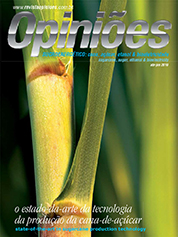Hélio do Prado
Director of the Information and Knowledge Tranfer of IAC
Op-AA-24
Sugarcane production environments
Businesspersons increasingly depend on knowledge about the climate and soil to achieve success in their economic activity, which results in knowledge about the behavior of several sugarcane varieties. To achieve this success, one must first of all know not only about the climate (precipitation and rain distribution in the course of several months, day and night temperatures, annual hydric deficiency, and wind behavior), but also about sugarcane soils.
To classify different soils is important to organize knowledge on research and agricultural practice. If a same variety of sugarcane of similar age develops more firmly on one plot, considering the same climate and phytosanitary and management conditions, then probably the soils differ in terms of chemical, physical and morphological characteristics.
Production environment is the similarity in average productivity of sugarcane varieties over time, as a function of climate interaction with soils, in addition to the beneficial effects of different management levels (high, average or low). The Ambicana project of the Procana program specifically studies soils, seeking to understand the respective sugarcane production environments, and is coordinated by me and Marcos G.A.Landell, the re-searchers of IAC’s Sugarcane Center.
Until now it has studied soils and the respective production environments of 55 mills in Brazil and is currently conducting studies in the mills Zilor in Lençóis Paulista, SP, Tropical and Denusa, both in Goiás, and in tests under the Procana program in the Sugarcane Center in Brazil and in the mills Tres Valles and Lopez Mateos in Mexico.
Ambicana’s main objective is to teach criteria for sampling, classifying soils and sugarcane production environments to specialists of sugar and ethanol companies, involving individually differentiated intensive monitoring of such specialists until they are knowledgeable in the matter, while believing, as does the Executive Board, in the trained specialists’ capacity.
On the other hand, companies that invested in IAC to study production environments and applied their practical concept knowledge confirm that they achieved positive economic results due to the project. The interpretation of data, including concepts about groundwater, first adopted by IAC, has been performed since the project started, without any change of its guidelines, and furthermore, resulted in a practical soil chart.
The central concept of production environments at the IAC is to, in the chart, take into consideration dif-ferent climate regions and their soils: the mid-South, the most studied, the Northeastern region, recently studied with the forthcoming publication of a specific table on environments in that region, to be publicized in an upcoming congress.
To understand why high natural fertility soils are classified in unfavorable environments when water availability is low and soils with low natural fertility are classified in favorable environments when high water availability is average to high, is an important assessment to make, whose out-come we are increasingly publicizing. Therefore, at IAC, production environments are synonymous for ground-water and level of soil fertility considered individually.
This old theory is being adopted by its believers. Knowledge of the sugarcane matrix by Landell and collaborators, crossing information on types of soils and cutting periods (beginning, middle and end of harvest) is the main information generated in a company. However, to that end, first of all, a soil survey must be conducted, with adequate sample size definition, given soil variability in the field.
Another important aspect of Ambicana is the easy communication that occurs in publicizing knowledge and in understanding the practical soil chart, with its few symbols. Based on the ranges and combinations of values on clay, in Brazil there are four Latosols, six Argisoils, two Nitosoils, four Cambisols and two Quartzsandy Neosoils. These soils further break down based on their chemical and morphological characteristics of thickness and mainly of color.
For example, for IAC, soil symbolized as LVe-1, of very high natural fertility below the tillable layer, represents more restrictive Latosol in terms of the production environment because the hydric availability is among the lowest in the Latosol class, caused by the smaller percentage of clay in these soils. Every two years the Ambicana Seminar renews the opportunity for trained specialists to present their own data showing the importance of Ambicana in the search for return on investment in a project with a high cost/benefit relation.
In the second semester of 2010 this event will take place for the third time in IAC’s Sugarcane Center. More information on soils in sugarcane production centers is available in the site www.pedologiafacil.com.br, and in the books “Pedologia Fácil - Aplicações na Agricultura” by this author, and “Cana-de- Açúcar”, published by IAC’s Sugarcane Center.




